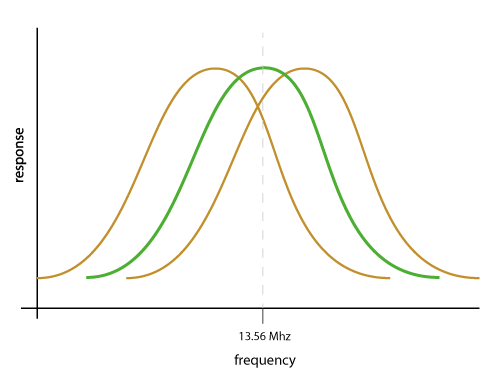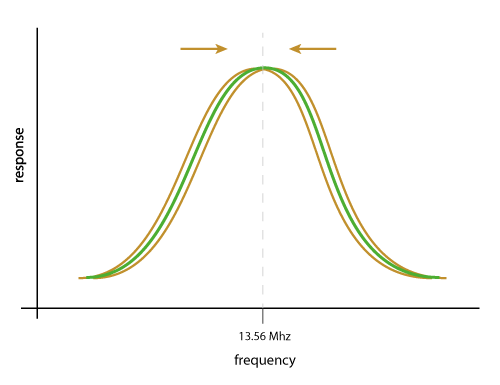
NXP have launched the next generation of their ICODE chip series - the ICODE 3. This chip is an NFC forum Type 5 tag and operates with ISO standard of ISO15693. With 300 bytes of memory and data retention of up to 50 years it has significantly longer life span than the NTAG series.
When comparing to previous ICODE chips there are some small improvements:
There's actually a number of ICODE variants including:
These tags all have slight specification variations. But we will focus on the new ICODE 3 compared to the ICODE SLIX 2 and ICODE SLIX.
| ICODE SLIX | ICODE SLIX 2 | ICODE 3 | |
|---|---|---|---|
| User Memory (Bytes) | 112 bytes | 316 bytes | 300 bytes |
| EAS Protection | 4 byte password | 4 byte password | 4 byte password |
| Persistant Quiet | No | Yes | Yes |
| Original Sign | - | Yes | 32/48 bytes customisable |
| Memory Protection | 4 byte password | 4 byte password | 4 byte password |
| Data Retention | 50 years | 50 years | 50 years |
| Write Endurance | 100,000 cycles | 100,000 cycles | 100,000 cycles |
| Standards | ISO15693 NFC Forum Type 5 |
ISO15693 NFC Forum Type 5 |
ISO15693 NFC Forum Type 5 |
| Read Speed (Max) | 53 kbit/s | 53 kbit/s | 212 kbit/s |
| NFC Mirror | - | - | UID / Counter |
| Counter | - | Yes | Yes |
| Capacitance | 23.5pf / 97pf | 23.5pf | 23.5pf / 97pf |
On the face of it, the differences between the ICODE 3 and ICODE SLIX 2 are minimal. In reality, for the majority of our users, the differences aren't going to be relevant. All three variants of the chip have the same lifespan and standards. However, there are a number of smaller improvements that make the ICODE 3 interesting for more specialist applications.
Security Features
The enhanced security features may appeal to large-scale ticketing or asset management applications, but they are unlikely to be relevant for most of our customers.
For customers looking for an ICODE chip with enhanced security, there's the ICODE DNA which allows Tag Authentication to 128bit AES. This chip does not allow doesn't allow for mirror of cryptographic data in the same way as the NTAG424. Therefore it is more suited for closed loop specialist applications.
Read Speed
NXP are advertising a faster read speed on the ICODE 3 of 212 kbit/s vs 53 kbit/s on the older chips.
This feature might be useful for large-scale, multi-tag reading, but most of our customers won't notice a difference. For example scanning with a mobile phone might speed up data transfer by less than 0.005 seconds.
NFC Counter / Mirror
While both the ICODE SLIX 2 and ICODE 3 have an NFC read counter, the ICODE 3 takes this a step further. Firstly, it's the first ICODE to have a mirror function where the scan count can be mirrored dynamically into the tag data - such as a URL.
Secondly, the ICODE 3 provides an additional Write counter (as well as the Read counter) and provides some functionality to control the counts.
Capacitance
This gets a little more complicated. To read more we have a separate article on how the capacitance of a chip affects the antenna design.
Like the original ICODE SLIX chip, the new ICODE 3 will be available with both 23.5pf and 97pf capacitance variants. This is important as the higher capacitance allows for a smaller antenna design - ie. smaller tags.
However, in real terms, we've always preferred the ICODE SLIX 2 to the ICODE SLIX.
Seritag testing shows a good 20% increase in scan performance of the ICODE SLIX compared to other tags. For the ICODE 3 the boost in scan performance will be beneficial.
One feature that is new to the ICODE 3 is NXP's SELFAdjust - and we consider this to be something special. To see the benefits, let's look at how NFC tags, especially their antennas, are made.
An NFC tag is composed of three main components: the NFC chip, the antenna, and a structure to hold everything together. The antenna is a loop of wire acting as an inductor which enables the reader to create an electromagnetic field and generate current.
For an NFC tag to work effectively, this coil of wire needs to be tuned to a specific frequency which is close to 13.56 Mhz. Tuning this frequency can be difficult. Even on high quality production lines, within a batch of antennas, the frequency can vary. Causing some NFC tags to not perform as well as expected.

NXP's SELFAdjust mechanism is designed to counteract this. The chip adjusts itself to small changes in antenna frequency to ensure all NFC tags in a batch work consistently. This is crucial when tags are used at their maximum scan distance.

This technology is clearly important for any NFC tag application but becomes critical when tags are used at the edge of their scan distance performance.
Unfortunately, as far as we can tell from the specifications, this SELFAdjust technology is only available on the 23.5pf version of the chip. As the performance of smaller tags is usually more critical because of the short scan distances, we would think that SELFAdjust would be more useful on the 97pf version. We are clarifying this with NXP to see if this is a datasheet error.
Although priced at a 5% premium compared to the ICODE SLIX 2, ICODE 3 is a great chip. This is not a huge difference but it's still 5% for features and performance you may not need. However we expect to see this narrow in the future when more chips become available.
An important consideration is that the ICODE SLIX has little protection against clone chip copies. Therefore we always recommend ICODE SLIX 2 against ICODE SLIX.
The new security features of the ICODE 3 make it ideal for applications that use the maximum scan distance. However, we'd still say the ICODE SLIX 2 is an excellent option until the pricing gap disappears.




